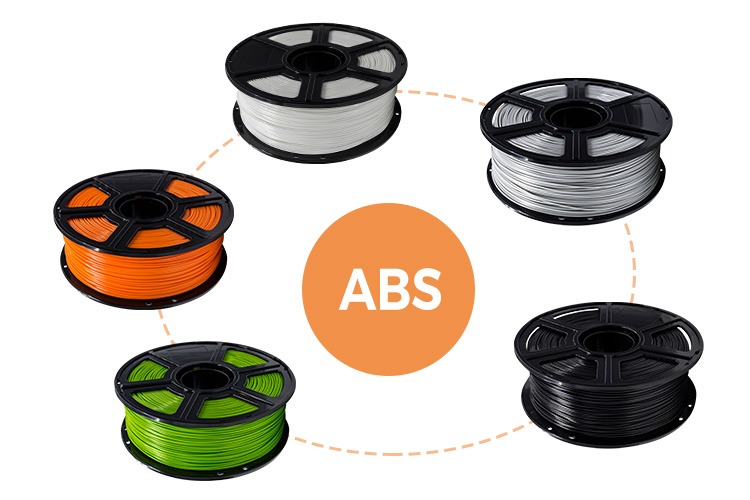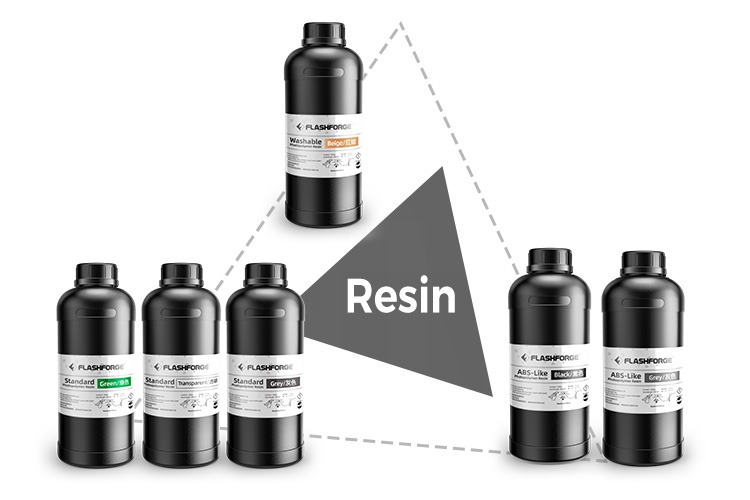Using the ideal 3D printing material to print 3D models is essential. 3D printing materials have a significant influence on the success of the 3D printing process. However, selecting the best 3D printing material can be intimidating as the list is quite long.
This article is designed to help you understand the most common 3D printing materials. You are going to understand the following by reading this article:
- The most common type of 3D printing materials, together with their benefits & demerits
- You’ll further get to understand the type of 3D printer which is used by each 3D printing material
Let’s get started!
Which is the Most Common 3D Printing Material for FDM 3D Printers?
Before diving in too deep, it would be best to note that FDM 3D printers are the most popular type of 3D printer. Their popularity is based on the fact that these printers are economical. In addition, their printing materials (thermoplastic filaments) are also economical.
Check out the most common 3D printing materials for FDM 3D printers:
Polylactic Acid (PLA)
PLA is a common 3D printing material for FDM 3D printers. It is environmentally friendly because it is made from organic sources, e.g., sugar cane & corn starch, which is renewable. It is biodegradable.
The reason why PLA is one of the most common 3D printing materials is that it is economical. You can print 3D models using this material easily as it requires low extrusion temperatures. It additionally does not produce strong odors compared to other thermoplastic filaments and does not require a heating bed.
PLA has a wide range of applications – it is primarily used in engineering industries, e.g., automotive, for rapid prototyping of non-functional models.
After printing, you can polish up your 3D model by sanding and painting it. You can additionally modify the printed model by drilling, milling, etc. However, you’ll need to do so slowly and ensure that the tools are cold to prevent melting.
| Pros | Cons |
| Easy to print | Low strength & heat resistance |
| Environmentally friendly | Does not interact well with food material when 3D printed |
| Wide range of applications | |
| Economical | |
| Good shelf life | |
| Wide range of color options | |
| Quick post-processing |
Acrylonitrile Butadiene Styrene (ABS)
ABS is yet another type of the most common 3D printing material for FDM 3D printers. The primary reason why ABS remains to be a popular choice is because of its low cost. It additionally has good mechanical properties.
ABS is tough – meaning it is durable and can withstand abrasion. ABS can further withstand high temperatures making it an ideal candidate for printing 3D models for outdoor applications. Please note that ABS produces odor during printing – you may need an open space or some fresh air.

Similar to PLA, ABS also has a wide range of applications. You can use ABS to print functional prototypes for the automotive industry. You can also use it to print toys and figurines, e.g., LEGO building blocks.
| Pros | Cons |
| Economical | Produces odor when printing and requires a heated bed during printing |
| High strength & impact resistance | Susceptible to warping and shrinking |
| Heat resistant | |
| Wide range of applications | |
| Smooth surface finish |
Honorable Mention: High Impact Polystyrene (HIPS)
HIPS is a lightweight support material popularly used with ABS. It is a common 3D printing material that should be used when printing 3D models with complex geometries. The best part about using HIPS as a support material is that it is dissolvable in d-limonene.
You can, therefore, print complex 3D models and remove this support material without leaving any marks on the main 3D part. In addition to being a support material, HIPS can also be used in applications that require a filament that is lighter than ABS.
You can use HIPS to print functional prototypes as it has good impact resistance and excellent dimensional stability. Similar to ABS, you’ll certainly need an open space or fresh air when printing 3D models using HIPS. It produces a strong odor during printing.
| Pros | Cons |
| Economical | Requires the use of a heated during printing |
| Water & impact resistant – dissolves in d-limonene. | High printing temperature and ventilation are required. |
| Lightweight | |
| Wide range of applications | |
| Smooth surface finish |
Which is the Most Common 3D Printing Material for 3D Resin Printers?
There are two popular types of 3D resin printers:
- LCD 3D resin printer
- DLP 3D resin printer
Each of the above printers relies on photosensitive resins as their primary 3D printing materials. Check out some of their most common 3D printing materials:

Standard Resin (for both LCD and DLP 3D Resin Printers)
3D resin printers use standard resin which is the most common 3D printing material. Both LCD and DLP 3D resin printers can use standard resin to print 3D models. However, it would be best to specify your resin 3D printer when buying this resin.
The reason why the standard resin tops the list for the most common 3D printing material is that it is economical. It additionally prints high-quality 3D models with unparalleled surface qualities.
Most people use standard resin for general 3D printing. You can, therefore, print prototypes with limited functionalities, figurines, model houses, ships, trains, etc. The best part about using this resin is that it has a wide range of colors.
It, therefore, means that you can color-code your 3D models, which is an added advantage, e.g., during demonstration purposes.
Now, it is important to note that 3D models with complex geometries require the use of support material. You should remove the support material after printing is complete. Standard resin allows you to manually remove the support material as its post-process is uncomplicated.
After removing the support material, it would be best to paint (or varnish) the surfaces of the 3D model. It’ll help protect the model’s color, especially from UV rays. This post-process is essential because resin 3D printing materials in general, are photosensitive.
| Pros | Cons |
| Economical and easy to print | Limited on strength and impact |
| Easy post-process | Strong odor when printing |
| Lightweight | |
| Wide range of colors | |
| Wide range of applications |
ABS-like Resin for LCD 3D Resin Printers
ABS-like resin is similar to the FDM 3D printer’s ABS thermoplastic filament, as the former mimics the latter’s performance. In addition to being tough, ABS-like resin is capable of producing high-quality 3D models with smooth surfaces.
ABS-like resin is economical and has a wide range of uses because of its outstanding mechanical properties. It is widely used in engineering and medical industries for the rapid prototyping of model parts. ABS-like resin is also an ideal candidate for static modeling.
| Pros | Cons |
| Economical | Low flexibility |
| High strength and impact-resistant | Poor outdoor performance |
| No odors – safe for indoor use | |
| Wide range of applications |
Dental Resin for DLP 3D Resin Printer
Dental resin is mainly used to print dental 3D models which are essential in any dental lab. This resin produces biocompatible dental surgical guides which have low failure rates. It, therefore, means that dentists can use this resin to print crowns, aligners, retainers, etc.
Leading dentists have admitted that using dental resins has helped solve lots of problems without consuming a lot of time. Printing a patient’s oral cavities using dental resins is accurate and working with digital files is easy.
Dental resin paired with a DLP 3D resin printer will enable you to print 3D dental models which are detailed. It is further safe for indoor use as it does not produce a strong odor.
| Pros | Cons |
| Low odor during printing | Can easily stain e.g., when drinking red wine or taking coffee |
| Low shrinkage with excellent dimensional stability | Grinding when chewing makes the resin wear out sooner |
| Biocompatible | |
| Heat-resistant (aligners) |
Which is the Most Common 3D Printing Material for Wax 3D Printers?
Another common 3D printing material is wax. There are three primary wax 3D printing materials in the market today:
- Wax 3D printing material for parts (general wax 3D printing)
- Wax 3D printing material for dental
- Support material for printing 3D models with complex geometries.
Using wax 3D printing materials is beneficial. Wax is environmentally friendly compared to other 3D printing materials, such as FDM 3D printing thermoplastic filaments. In addition, wax 3D printing materials do not produce strong odors when printing.
General wax 3D printing material has a wide range of applications. You can use it to print jewelry, figurines, non-functional prototypes, etc. It, therefore, means that using wax for 3D printing produces high-detail models.
Similar to standard resin, general wax 3D printing material has a wide range of colors that allow you to color-code your 3D models.
Additionally, wax 3D printing material does not require a lot of energy to melt, meaning that you can easily print high-detail models. Dental wax 3D printing material is ideal for printing dental models quickly.
Dental wax helps dentists print dental models quickly and easily with a lot of accuracy and detail to the model. It additionally has a low shrinkage factor.
If your 3D models have complex geometries, consider using the wax support material which is easily removable at the end of the printing process. This support material has the lowest melting point compared to the other two.
| Pros | Cons |
| Environmentally-friendly | Should not be exposed to high temperatures |
| Easy to use | Costs more than FDM and resin 3D printing materials |
| Moisture and water-resistant | |
| Easy post-process | |
| Wide range of colors and applications |
Final Thoughts on Common 3D Printing Materials
Selecting the right 3D printing material is essential for any successful 3D printing process. This article has taken an in-depth look at the most common 3D printing material according to each printer.
